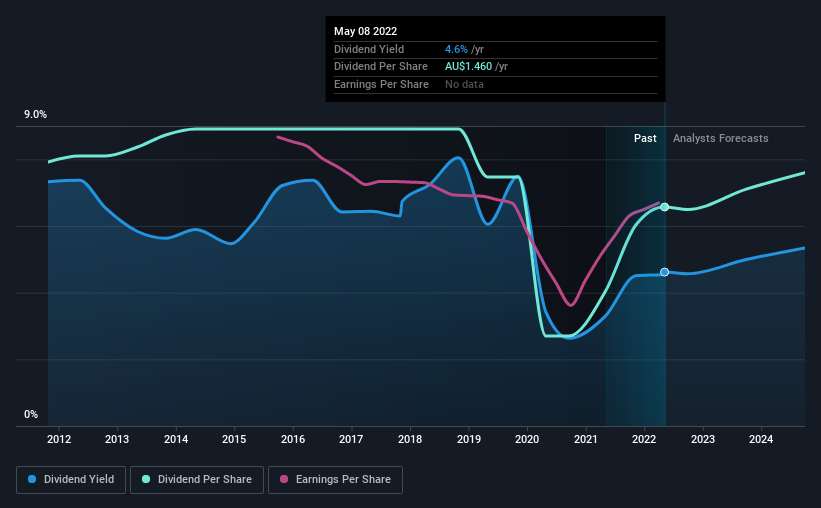National Australia Bank's (ASX:NAB) Dividend Will Be Increased To AU$0.73
National Australia Bank Limited (ASX:NAB) has announced that it will be increasing its dividend on the 5th of July to AU$0.73. This takes the annual payment to 4.4% of the current stock price, which is about average for the industry.
See our latest analysis for National Australia Bank
National Australia Bank's Earnings Easily Cover the Distributions
We like to see a healthy dividend yield, but that is only helpful to us if the payment can continue. Based on the last payment, National Australia Bank's earnings were much higher than the dividend, but it wasn't converting those earnings into cash flow. In general, we consider cash flow to be more important than earnings, so we would be cautious about relying on the sustainability of this dividend.
Over the next year, EPS is forecast to expand by 1.7%. If the dividend continues along recent trends, we estimate the payout ratio will be 57%, which is in the range that makes us comfortable with the sustainability of the dividend.
Dividend Volatility
The company has a long dividend track record, but it doesn't look great with cuts in the past. Since 2012, the dividend has gone from AU$1.76 to AU$1.46. Doing the maths, this is a decline of about 1.9% per year. Declining dividends isn't generally what we look for as they can indicate that the company is running into some challenges.
National Australia Bank May Find It Hard To Grow The Dividend
Growing earnings per share could be a mitigating factor when considering the past fluctuations in the dividend. Although it's important to note that National Australia Bank's earnings per share has basically not grown from where it was five years ago, which could erode the purchasing power of the dividend over time.
National Australia Bank's Dividend Doesn't Look Sustainable
Overall, this is probably not a great income stock, even though the dividend is being raised at the moment. While the low payout ratio is redeeming feature, this is offset by the minimal cash to cover the payments. Overall, we don't think this company has the makings of a good income stock.
It's important to note that companies having a consistent dividend policy will generate greater investor confidence than those having an erratic one. Meanwhile, despite the importance of dividend payments, they are not the only factors our readers should know when assessing a company. Just as an example, we've come across 2 warning signs for National Australia Bank you should be aware of, and 1 of them is significant. If you are a dividend investor, you might also want to look at our curated list of high yield dividend stocks.
Have feedback on this article? Concerned about the content? Get in touch with us directly. Alternatively, email editorial-team (at) simplywallst.com.
This article by Simply Wall St is general in nature. We provide commentary based on historical data and analyst forecasts only using an unbiased methodology and our articles are not intended to be financial advice. It does not constitute a recommendation to buy or sell any stock, and does not take account of your objectives, or your financial situation. We aim to bring you long-term focused analysis driven by fundamental data. Note that our analysis may not factor in the latest price-sensitive company announcements or qualitative material. Simply Wall St has no position in any stocks mentioned.

 Yahoo Finance
Yahoo Finance 
